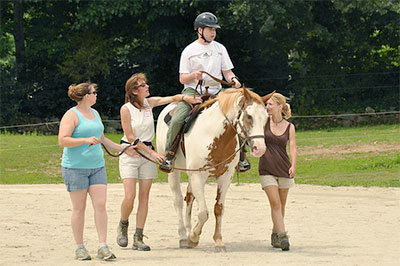What is Hippotherapy?
The horse is unlike any other therapy tool
Movement: A horse's motion is rhythmic and symmetrical. As the horse moves, a participant responds by developing new movement strategies to maintain balance. By altering the horse's gait and direction, the therapist creates a "just-right" challenge for each participant.
Motivation: Horses are safe, non-judgmental companions who offer a sense of connection sometimes missing from human relationships. This bonding, along with the opportunity to alter the routine of clinic or school, shifts the dynamic of therapy, making it more enjoyable and less like work.
Environment: Spending time in green spaces has a calming effect on the human nervous system. Participants visiting stables and farms enter inspiring environments for learning new skills.
What diagnoses are commonly treated with hippotherapy?
- autism
- cerebral palsy
- developmental delay
- multiple sclerosis
- stroke
- traumatic brain injury
What areas can demonstrate improvement as a result of hippotherapy?
- Postural control
- Balance reactions
- Sensory modulation
- Bilateral coordination
- Awareness of position in space
- Midline orientation
- Hip, pelvic and spinal mobility
- Respiratory function
- Problem-solving movement strategies in changing environments
- Normalized muscle tone
How is hippotherapy different from therapeutic/adaptive riding?
While hippotherapy and adaptive riding may look similar at times, they have different purposes.

Hippotherapy is a treatment used by trained therapists to address specific limitations caused by a disability, helping a participant to accomplish their therapy goals. During a typical hippotherapy session, the participant does not control the horse or learn skills to control the horse.
In therapeutic horsemanship, a specially-trained instructor teaches the skills needed to handle and ride a horse. For more information about therapeutic or adaptive horsemanship, visit PATH International (Professional Association of Therapeutic Horsemanship).
How safe is hippotherapy?
The horses receive special training to become accustomed to different positions, as well as becoming familiar with the toys and props used in therapy. The horse handlers are skilled horse people who are very familiar with the horses. In addition, all horse handlers, therapists and sidewalkers are trained to anticipate potential risks and use emergency dismount procedures, if necessary. However, there is an inherent danger in working with horses, as they always have the capacity to startle and dislodge the participant. Ultimately, the participant and his or her guardian must decide that the potential benefits outweigh the inherent risks.
Have more questions?
The American Hippotherapy Association has additional information about this treatment strategy. You're also welcome to contact us to learn more — we're happy to help!